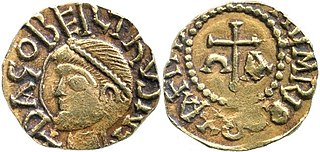
The Basilica of Saint-Denis is a large former medieval abbey church and present cathedral in the commune of Saint-Denis, a northern suburb of Paris. The building is of singular importance historically and architecturally as its choir, completed in 1144, is widely considered the first structure to employ all of the elements of Gothic architecture.

Dagobert I was the king of Austrasia (623–634), king of all the Franks (629–634), and king of Neustria and Burgundy (629–639). He has been described as the last king of the Merovingian dynasty to wield any real royal power. Dagobert was the first of the Frankish kings to be buried in the royal tombs at Saint Denis Basilica.

Seine-Saint-Denis is a department of France located in the Grand Paris metropolis in the Île-de-France region. In French, it is often referred to colloquially as quatre-vingt treize or neuf trois, after its official administrative number, 93. Its prefecture is Bobigny.

Charles de Marguetel de Saint-Denis, seigneur de Saint-Évremond was a French soldier, hedonist, essayist and literary critic. After 1661, he lived in exile, mainly in England, as a consequence of his attack on French policy at the time of the Peace of the Pyrenees (1659). He is buried in Poets' Corner, Westminster. He wrote for his friends and did not intend his work to be published, although a few of his pieces were leaked in his lifetime. The first full collection of his works was published in London in 1705, after his death.

Dagobert II was a Merovingian king of the Franks, ruling in Austrasia from 675 or 676 until his death. He is one of the more obscure Merovingians. He has been considered a martyr since at least the ninth century.

François-Jean Lefebvre de la Barre was a young French nobleman. He was tortured and beheaded before his body was burnt on a pyre along with Voltaire's Philosophical Dictionary nailed to his torso. La Barre is often said to have been executed for not saluting a Roman Catholic religious procession, though other charges of a similar nature were laid against him.
Pierre Plantard de Saint-Clair was a French draughtsman, best known for being the principal perpetrator of the elaborate Priory of Sion hoax, by which he claimed from the 1960s onwards that he was a direct and legitimate male line Merovingian descendant of Dagobert II and the "Great Monarch" prophesied by Nostradamus. Today in France, he is commonly regarded as a con artist.

The French Crown Jewels comprise the crowns, orb, sceptres, diadems and jewels that were symbols of Royal power between 752 and 1825. These were worn by many Kings and Queens of France. The set was finally broken up, with most of it sold off in 1885 by the Third Republic. The surviving French Crown Jewels, principally a set of historic crowns, diadems and parures, are mainly on display in the Galerie d'Apollon of the Louvre, France's premier museum and former royal palace, together with the Regent Diamond, the Sancy Diamond and the 105-carat (21.0 g) Côte-de-Bretagne red spinel, carved into the form of a dragon. In addition, some gemstones and jewels are on display in the Treasury vault of the Mineralogy gallery in the National Museum of Natural History.

Melle is a commune in the Deux-Sèvres department in western France. On 1 January 2019, the former communes Mazières-sur-Béronne, Paizay-le-Tort, Saint-Léger-de-la-Martinière and Saint-Martin-lès-Melle were merged into Melle.

The Crown of Charlemagne was a name given to the ancient coronation crown of Kings of the Franks, and later Kings of France after 1237.

"Le bon roi Dagobert", also called "Le roi Dagobert a mis sa culotte à l’envers", is an old French song featuring King Dagobert and Saint Eligius, two historical people. The song was created in the 1750s and was intended to ridicule royalty. It was inspired by tales of debauchery of the life of Dagobert I.

Denys Louis de Rougemont, known as Denis de Rougemont, was a Swiss writer and cultural theorist who wrote in French. One of the non-conformists of the 1930s, he addressed the perils of totalitarianism from a Christian point of view. After the Second World War, he promoted European federalism.

Saint-Lazare Prison was a prison in the 10th arrondissement of Paris, France.

Wimmenau is a commune in the Bas-Rhin department in Grand Est in north-eastern France.

The Throne of Dagobert or Chair of Dagobert is a bronze chair made in the early Middle Ages and long associated with the Frankish and later French monarchy. After having been kept for centuries at the Abbey of Saint-Denis, it is now at the Cabinet des médailles of the Bibliothèque nationale de France in Paris.

Le Temps des cerises is a song written in France in 1866, with words by Jean-Baptiste Clément and music by Antoine Renard, extremely famous in French-speaking countries. The song was later strongly associated with the Paris Commune, during which verses were added to the song, thus becoming a revolutionary song. The "Time of Cherries" is a metaphor regarding what life will be like when a revolution will have changed social and economic conditions. It is believed to be dedicated by the writer to a nurse who fought in the Semaine Sanglante when French government troops overthrew the commune.

Ligier Richier was a 16th-century religious sculptor working in Lorraine, France and known in particular for his depictions of scenes from the "Passion of Christ". The various episodes of the Passion, between the arrest and the crucifixion of Christ, as recounted in the Gospels, were increasingly subject to representation in the Arts towards the end of the Middle Ages, in tandem with the growing popularity of the staging of theatrical mystery plays.

Saint-Denis is a commune in the northern suburbs of Paris, France. It is located 9.4 km (5.8 mi) from the centre of Paris. Saint-Denis, which had a population of 112,091 as of 2018, is a subprefecture of the department of Seine-Saint-Denis, being the seat of the arrondissement of Saint-Denis.

The Neirab steles are two 8th-century BC steles with Aramaic inscriptions found in 1891 in Al-Nayrab near Aleppo, Syria. They are currently in the Louvre. They were discovered in 1891 and acquired by Charles Simon Clermont-Ganneau for the Louvre on behalf of the Commission of the Corpus Inscriptionum Semiticarum. The steles are made of black basalt, and the inscriptions note that they were funerary steles.
The Treasury of Saint-Denis, kept at the Basilica of Saint-Denis in Paris until the French Revolution, was the main repository of the regalia of the Kingdom of France, including the ancien régime portion of what are now known as the French Crown Jewels. Its surviving items are presently scattered between the Louvre, the Cabinet des Médailles of the French National Library, and other museums.


















